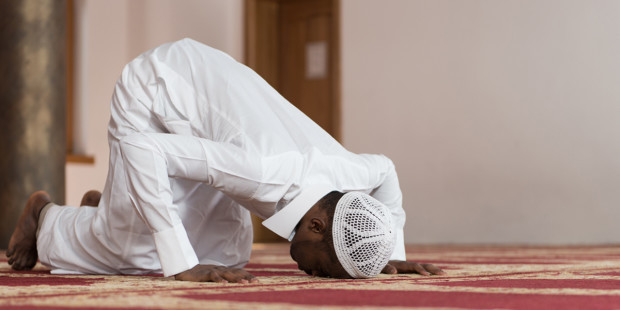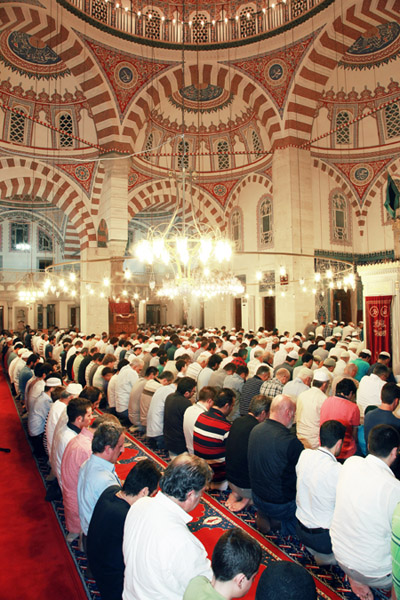Current Section: model

Lesson Description of the Prayer
1. Intention (Niyyah)
The intention is a condition for the prayer to be valid. Before offering the prayer, one must have in mind the intention to provide the specified prayer, such as the sunset prayer or the late evening prayer, for instance, to worship Allah. A Muslim must not say the intention out loud; to do so would be a mistake because the Prophet ﷺ or his noble companions have never been reported as doing so.
He stands for prayer and says, “Allah is Most Great (Allaahu Akbar),” raising his hands to the level of the shoulders or a little above that, with the palms of his hands facing the Qiblah.

The Meaning of Takbeer
The takbeer is not valid except by saying “Allahu Akbar.” It means to praise and glorify Allah. Indeed, Allah is more significant than everyone and everything else. He is greater than this world and all its desires and pleasures. Therefore, when we declare the takbeer, we leave the worldly concerns and earthly desires behind us and turn towards Allah, the mighty and most high, in prayer, with our hearts and minds in a state of utmost humility.
3. After takbeer, he places his right hand on his left hand on his chest. He maintains this whenever he is in a standing position.
4. He recites the opening supplication that has been established from the Prophet ﷺ which include this one: 'Glory and praise be to you, O Allah, blessed be Your name and exalted be Your Majesty; there is no god but You.'
5. He says: 'I seek Allah's protection from Satan, who has been expelled from His mercy.' This is phrase for seeking refuge, which means to turn to Allah to seek protection from the evil of Satan.
6. He says: 'In the name of Allah, Most Beneficent, Most Merciful.' This means: I start by seeking aid and blessings in Allah's name.
7. He recites Surah Al-Fatiha, the greatest surah in the Quran.
7. He recites Surah Al-Fatiha, the greatest surah in the Quran. Allah reminds his Messenger of His favor upon him by revealing it to him: (We have given you the seven oft-repeated verses and the glorious Quran.) [Al-Hijr:87] The seven oft-repeated verses are Surah Al-Fatiha. It is called so because it is composed of seven verses repeated by people several times daily.
A Muslim must learn it by heart, for reciting it in prayer constitutes one of the pillars of the prayer for whoever prays alone or behind the Imam, in prayers during which Quranic verses are repeated in a low voice.
Surah Al-Fatiha
8. After reciting Surah Al-Fatiha or listening to it behind the Imam, he says: 'Ameen,' meaning "O Allah, answer (my supplication)."
9. After reciting Surah Al-Fatiha in the first and second raka’at, he recites another surah or other Quranic verses. In the third and fourth raka’at, he repeats only Surah Al-Fatiha.
Surah Al-Fatiha and Quranic verses that follow it usually are recited aloud at Fajr and the first and second Raka’at during Maghrib and Isha. As for Dhuhr and Asr, they are recited quietly. Likewise, all the supplications are recited in a low voice.
10. Then he says the takbeer while raising his hands to the level of the shoulders or a little above them, with the palms of his hands facing the Qiblah, the same as is done for the very first takbeer.
11. He bows down, lowering his head and back, keeping them straight at a right angle, and spreading his fingers over his knees. He says three times, “Glory be to my Lord, the Almighty.” It is obligatory to say this only once but recommended to say it three times. The bowing is a position in which Allah is glorified and praised.

“Glory be to my Lord, the Almighty” means: I declare Allah free from all defects and recognize His absolute perfection. He recites these words while bowing.
12. He raises his hands to shoulder level, with the palms of his hands facing the Qiblah, saying, 'Allah listens to him who praises Him.' He says this whether he is praying alone or he is the Imam; then everyone says: 'Our Lord, to You, is due all praise.'

It is recommened to say after this: “An abundant, beautiful, and blessed praise is recommended. Praise that fills the heavens, the earth, and all that You will after that.”
He recites the takbeer and prostrates with the following seven body parts touching the floor: The forehead, nose, feet, and knees. It is recommended not to bring the arms close to the sides of the abdomen close to the thighs, ensuring that his forearms are not in contact with the floor.

He says in prostration: "Glory is to my Lord, the Highest," meaning: I declare that Allah, the Highest, the Almighty, who is above the heavens, is free from all defects. This statement reminds the worshipper, who is humbly prostrating himself, of the difference between him and his Almighty Creator, prompting him to submit to his Protector humbly.
The prostrate position (Sujud) is the noblest state of supplications to Allah. A Muslim is recommended to invoke Allah, after the obligatory words of remembrance, and ask Him for anything which he wants in this life or in the hereafter. The Prophet ﷺ said: «The nearest a servant can be to his Lord is when he prostrates himself in prayer. So, invoke Allah much in this state.» (Muslim, 482)
15. Then he recites the takbeer and sits between the two prostrations. It is recommended to sit with the left buttock on the ground, the right foot placed vertically, and the left foot on its side emerging from underneath the right foot.

Description of the Sitting in the Prayer
All the sittings in the prayer should be done the way previously mentioned, except for the final 'tashahud' where he rests on his right leg. However he pushes out his left foot from underneath him and sits on the floor.
16. When sitting between the two prostrations, he says: (My Lord, forgive me), and it is recommended to repeat it three times.
17. Then he prostrates again as he did the first time.

18. Then he gets up from the second prostration to the standing position, saying ( Allah is great).
19. He prays the second rak’ah the same as the first.
20. After his second prostration in the second rak’ah, he sits for tashahhud as he sits between the two prostrations, pointing with the forefinger of his right hand in the direction of the qiblah and saying: 'And I bear witness that there is no worthy of worship except Allah, and Muhammad is His slave and Messenger.'
21. If the prayer is two rak'ahs, like the dawn prayer, it comes with the Abrahamic prayer, then he makes tasleem, and that will be explained later, but if the prayer is three rak'ahs or four rak'ahs, then he should stand for the rest of his prayer, except that he only recites in the third and fourth rak'ahs surah Al-Fatihah.
22. Then, in the last rak’ah after the second prostration, he sits for the final tashahhud. Its description is to sit on his buttocks and, hold his right foot up, place his left leg under his right foot, and say what he said in the first tashahhud, then say the Abrahamic prayers: “O Allah, send salutations upon Muhammad and the family of Muhammad, as you sent salutations upon the family of Abraham, you are Praiseworthy and Glorious, and bless Muhammad and the family of Muhammad, as you blessed the family of Abraham, you are Praiseworthy and Glorious.
It is recommended to say after that: (I seek refuge in Allah from the torment of Hell, the suffering of the grave, the trials of life and death, and the trials of the Antichrist) and to supplicate with whatever he likes.
23. Then he turns to the right, saying: (Peace be upon you and the mercy of Allah), then to the left and says the same, and with this tasleem, the Muslim will have finished his prayer as Prophet ﷺ said: «It starts with the first takbeer and its ends with the tasleem.» (Abu Dawud, 618, Al-Tirmidhi, 3) He enters the prayer with the first takbeer and exits with the tasleem.
24. After the salaam of the obligatory prayer, it is recommended to say:
He must strive very hard to memorize Al-Fatihah in Arabic because it is not valid in any other language. He must also strive to learn the obligatory dhikrs in prayer, including Surah Al-Fatihah and the takbeer. Glory be to my Lord, the Great. And Allah hears those who praise Him. Our Lord, praise be to you. Glory be to my Lord, the Most High. Lord, forgive me. The tashahhud and prayers upon the Prophet ﷺ, and the tasleem ( Peace and mercy of Allah be upon you.)

And until he memorizes it, he must repeat during the prayer the glorification, praise, and takbeer of what he knows, or repeat the verse that he has memorized while standing, due to saying of Allah: (So fear Allah as much as you can.) [Al-Taghabun:16]
He should be very keen, as much as he can, to pray with the congregation to learn to correct his prayer because the imam bears some of the shortcomings of those being led in the prayer.



